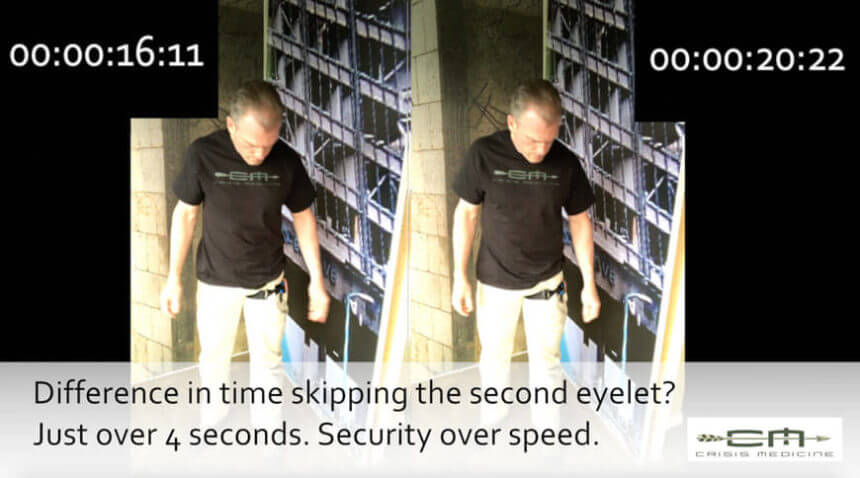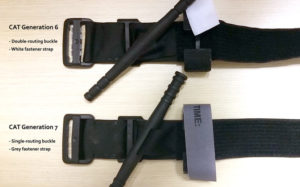
Single vs Double Routing of the Eyelet on the CAT Tourniquet
- Posted by Mike Shertz MD/18D
- Categories (M) Massive Hemorrhage, Equipment
Change in CAT tourniquets from 6th to 7th generation
🕖 Reading Time, 4 minutes
In October 2015, the 6th generation Combat Application Tourniquet, or CAT, with its double-eyelet buckle was discontinued, in favor of the 7th generation CAT which has only a single-eyelet routed buckle. In 2013, Dr. Kragh published an article citing a 23% rate of CAT tourniquets with the double-eyelet buckle being single-eyelet routed on lower extremity applications for hemorrhage control. Although this tourniquet technique is appropriate when self-applying the CAT on an upper extremity, proper lower extremity application required routing the tourniquet band through both holes of the double-eyelet. This secured the tourniquet with both friction through the double eyelet and with the Velcro band.

Actual differences in application time
However, the median differences (middle result, with as many results above and below it, not the mean/average where one big result/number pushes the entire mean upward) was a time difference of 3.5 seconds, favoring the single routing. The single routing resulted in a median decrease of only 8 ml of simulated blood loss, representing only about 1.5 teaspoons less blood or the equivalent of three Vacutainer®1 tubes (much less than the typical five to eight tubes of blood drawn on initial trauma center evaluation).

Although in concept, any technique that decreases blood loss is a good thing, there are always trade-offs. In this case, using the single routed eyelet for leg application requires reliance on only the Velcro of the tourniquet band to hold pressure. If the Velcro fails or releases, the entire tourniquet would disengage with catastrophic results.
Dr. Kragh stated as long as 1.6 inches of Velcro on the tourniquet was adhered, it would hold. Unfortunately, that has not been our experience in training, where such a short piece of attached Velcro frequently fails, especially when dragging casualties to safety.
Training issue or design issue?
Instead of calling the incorrect single-eyelet leg applications a tourniquet training issue, the military, armed with Dr. Kragh’s study showing decreased blood loss, demanded the CAT be redesigned to eliminate the need to route the tourniquet through the double-eyelet on legs. This lead to the redesigned “7th generation” CAT.
One could argue that such a significant design change renders all of the previously studied volunteer and combat applications of the CAT tourniquet irrelevant. In turn, that means the 7th generation CAT is technically unproven, as those kinds of studies don’t yet exist proving success of that device. Of course, the same argument can be applied to the current (2nd) generation of the recently redesigned SOFT-Wide.
Conclusion? Velcro can fail.
Until more literature is available, we are in no hurry to replace our 6th generation CAT tourniquets. Velcro fails. That is why the leg and chest straps on your parachute harnesses aren’t secured with just Velcro…
Don’t take our word for it, read the article, not just the abstract or their conclusions:
Single versus Double Routing of the Band in the Combat Application, BR Clumpner,Polston RW, Kragh et al, J Spec Oper Med. 2013 Spring;13(1):34-41. Single versus Double Routing of the Band in the Combat Application Tourniquet.
1 Vacutainer® is a registered trademark of Becton, Dickinson and Company.
Dr. Mike Shertz is the Owner and Lead Instructor at Crisis Medicine. Dr. Shertz is a dual-boarded Emergency Medicine and EMS physician, having spent over 30 years gaining the experience and insight to create and provide his comprehensive, science-informed, training to better prepare everyday citizens, law enforcement, EMS, and the military to manage casualties and wounded in high-risk environments. Drawing on his prior experience as an Army Special Forces medic (18D), two decades as an armed, embedded tactical medic on a regional SWAT team, and as a Fire Service and EMS medical director.
Using a combination of current and historical events, Dr. Shertz’s lectures include relevant, illustrative photos, as well as hands-on demonstrations to demystify the how, why, when to use each emergency medical procedure you need to become a Force Multiplier for Good.



